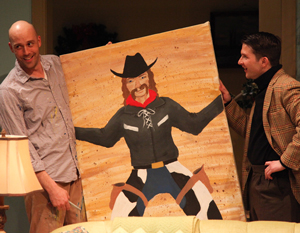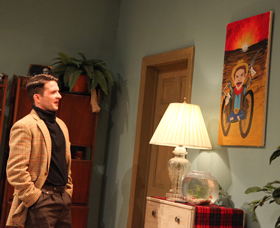
The suffering of families with children crippled by disease are commonplace themes nowadays, but in 1967, Peter Nichols' A Day In The Death of Joe Egg shocked audiences with its brutally unsentimental account of an English couple whose severely disabled 10-year-old daughter's almost nonexistent brain activity renders her barely more vital than the household pets and plants. Her name is Josephine, but her parents, Brian and Sheila, have taken to calling her "Joe Egg"—the British equivalent to our "bump on a log"(as in "sitting there, doing nothing, like a...")
Brian paints on his weekends—images of a fantasy American West (much as a troubled father in, let's say, Wichita, might paint sailing ships). Two of his canvases are on display in the living room, while a third is brought in for viewing by visitors. What should we, cognizant as we are of their creator's experience, see in these expressions of his emotional malaise?
Director Greg Werstler and property designer Cassy Schillo started with nothing but Brian's own descriptions of his subjects: a solitary figure he identifies as Wild Bill Hickok is alleged to depict the man "just before his last poker game. They got him in the back." and a study of a cavalryman polishing his saddle is accompanied by the commentary, "Where's the sodding bugle-call? Only a few rounds left, and Sioux closing in!"
"Brian is looking for escape," explains Schillo, "He might have taken a few classes in his youth, but he's still an amateur. He paints because, in a house where the decor is almost wholly determined by Sheila and little Joe, his pictures are what makes it his home, too."
"These bigger-than-life figures also reflect his own loneliness," adds Werstler, "We see the extent of his withdrawal when he recounts an elaborate scenario surrounding the 'sodding bugle-call' picture to his friends, Freddie and Pam, who see nothing of it in the actual painting."
 The most disturbing of Brian's subjects is the vividly-colored portrait of a gunslinger with stunted arms and legs, perched atop a wheelchair, titled "The Thalidomide Kid." (Thalidomide was a drug prescribed to pregnant women in 1958, but withdrawn from use after thousands of babies were born with physical deformities.)
The most disturbing of Brian's subjects is the vividly-colored portrait of a gunslinger with stunted arms and legs, perched atop a wheelchair, titled "The Thalidomide Kid." (Thalidomide was a drug prescribed to pregnant women in 1958, but withdrawn from use after thousands of babies were born with physical deformities.)
"Cassy did the actual painting, but that one is so perfect! " Werstler declares, "I especially love the setting sun! Sheila probably allows it to be displayed in their living room because she sees it as a person overcoming his disability, but to Brian, all it does is to reaffirm his alienation."
Schillo shrugs, "Most untrained painters have problems with proportions. Brian may have made the head too big when he started, and decided to run with it."
Are these oil paintings? "Oh, Brian would never have the patience to paint with oils!" Schillo laughs, "They're acrylics—I painted them over three days, saving 'Wild Bill' for last, so that I could bring in Vance [Smith, who plays Brian] and stand him in front of the easel. This allowed us to estimate where someone of his height would naturally place the central figure, so that the picture would look like he painted it, not me."
Has anyone suggested auctioning off the collection after the play's run? "We haven't discussed it," Werstler muses, "We might just keep them in the office to remind us of the show."
A Day in the Death of Joe Egg runs at Theater Wit through February 16.
Mary Shen Barnidge
Contributing Writer

 Follow Us On Twitter
Follow Us On Twitter